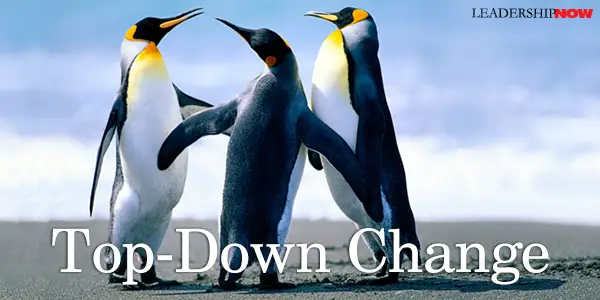 |
 |
01.28.08

Top-Down Change
THE following comment was made regarding John Kotter’s book Our Iceberg Is Melting and the 8-steps for leading change presented in it: “I've always interpreted John Kotter's 8 Step Change Framework as top-down. And since most top-down change fails, I've been wary of the 8 Steps.” Top-down change doesn’t fail because it is top-down. Top-down change fails – as does any kind of change – when it is not implemented properly. Hence, the need for Kotter’s eight-step change framework. “Top-Down” isn’t the problem. We need not be so afraid of it. Top-down hierarchies or approaches are common and natural in most efforts humans undertake to organize themselves. Top-down hierarchies unfortunately and incorrectly are often equated with authoritarianism. This is understandable. To be fair, it is common to find people at the top of these organizations that let their human nature get the best of them and become controlling, dictatorial, or just in general, inappropriate in their relationships with those under them. But it doesn’t make the organizational concept itself bad – just poorly executed. This isn’t a structure problem, but a human one. We need leaders that are humbled by their role and not taken by it. Certainly, change can be initiated from anywhere in an organization. A good leader knows that good ideas can be found at all layers of any organization and actively seeks them out. However, no matter who you are, when seeking to make a change, it should be remembered, that if those at the top of an organization, the leader of any group, or the designated decision-maker(s), don’t see the value of the change and commit to it, the change will fail regardless of the perceived structure or where it is coming from—up or down. Even “leaderless” organizations (an authority-disguising term itself) have structure and levels of authority even if temporary or shifting. Change happens when someone commits to a new way of doing things and leads others to do the same. There are processes, like Kotter’s 8-step program, that help one to do that. The principles apply whether one is leading top-down, up, or even among a group of friends. Wherever you find yourself in a hierarchy, your change initiative must be communicated properly for others to receive it or act upon it. Kotter’s first step is to take the issue to the right people. At that moment you are in the driver’s seat. 
Posted by Michael McKinney at 03:23 PM
|
BUILD YOUR KNOWLEDGE
 

How to Do Your Start-Up Right STRAIGHT TALK FOR START-UPS 
Grow Your Leadership Skills NEW AND UPCOMING LEADERSHIP BOOKS 
Leadership Minute BITE-SIZE CONCEPTS YOU CAN CHEW ON 
Classic Leadership Books BOOKS TO READ BEFORE YOU LEAD |